h1>Somali (af Soomaali)
Somali is a member of the East Cushtic branch of the Afro-Asiatic language
family. It has 10-16 million native speakers and perhaps half a million second
language speakers mainly in Somali, where it is an official language, Ethiopia,
Djibouti and Kenya. There are also significant numbers of Somali speakers in
Europe, North America and Yemen.
Somali has been written with four different scripts: an Arabic-based abjad
known as Wadaad’s writing, a Latin-based
alphabet and two native alphabets, the Osmanya script
and the Borama script.
Wadaad’s writing (Arabic script)
The Arabic script was first introduced in the 13th century by Sheikh Yusuf
al-Kowneyn to aid Koranic teaching. In the 19th century Sheikh Uways al-Barawi
improved the writing of Somali with the Arabic script and based it on the Maay
dialect of Southern Somalia. A Somali linguists, Muuse Xaaji Ismaaciil Galaal,
radically altered the spelling conventions for Somali written with the Arabic
script and introduced a set of new symbols for the vowels in the 1950s.
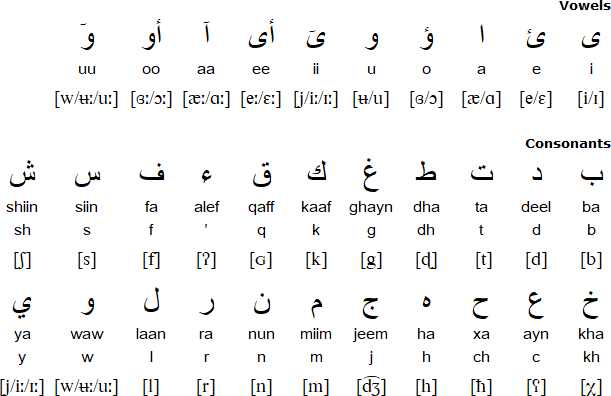
Source: http://www.afrikanistik-online.de/archiv/2010/2723
Sample text
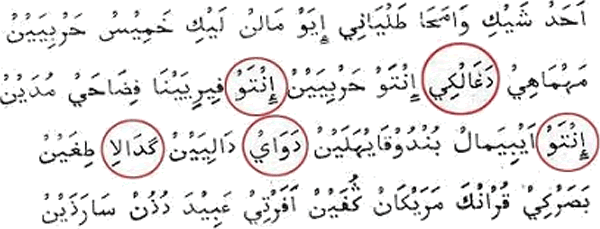
Borama/Gadabuursi alphabet
In 1933 Sheikh Abdurahman Sheikh Nuur invented another script for Somali
known as Borama or Gadabuursi which was only used by the Sheikh’s small
circle of associates in Borama.
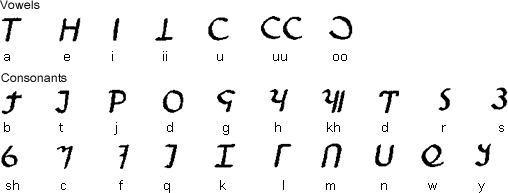
Sample text
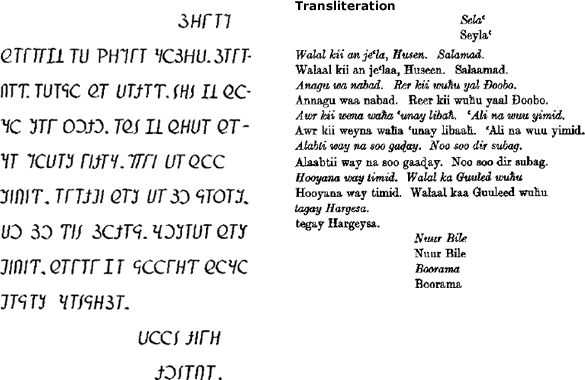
Translation
My beloved brother Huseen, Peace.
I am well, the reer is at Đoobo.
The big burden camel has been eaten by a lion. ‘Ali has come.
The goods have been received by us. Send us (some) ghee.
Out mother has come. Your brother Guuleed has gone to Hargeisa.
Nuur Bile,
Borama.
Somali/Osmanya alphabet
The Osmanya alphabet was created in between 1920 and 1922 by
Cismaan Yuusuf Keenadiid, brother of the Sultan of Obbia. In Somali it
is known as far soomaali (Somali writing) or cismaanya.
It replaced an attempt by Sheikh Uweys to devise an Arabic-based alphabet
for Somali, and has in turn been replaced by the Latin orthography of
Muuse Xaaji Ismaaciil Galaal (1914-1980).
The Osmanya alphabet is not used much these days, though during the
1970s quite a number of people used it for personal correspondence and
bookkeeping. A few books and magazines have also been published in the alphabet.
Notable features
- Direction of writing: left to right in horizontal rows.
- The names of the letters are based on Arabic letter names.
- The letters waw and ya are used to write the long vowels uu and ii respectively.
- Somali is a tonal language with four tones which are not usually
marked in writing. The tones have grammatical uses: theny indicate
number, gender and case.
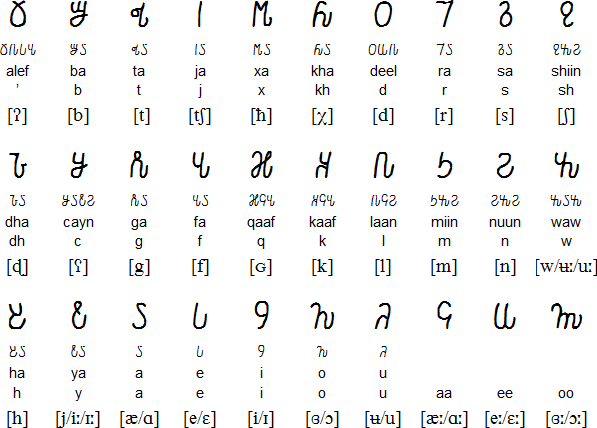
Numerals

Sample text

Latin alphabet for Somali
In 1961 both the Latin and Osmanya scripts were adopted for use in
Somalia, but in 1969 there was a coup, with one of its stated aims the
resolution of the debate over the country’s writing system. The Latin
alphabet was finally adopted in 1972 and at the same time Somali was
made the sole official language of Somalia. Shire Jama Ahmed (Shire Jaamac
Axmed / شيري جامع
أحمد) is credited with the invention
of this spelling system, and his system was chosen from among eighteen
competing new orthographies.
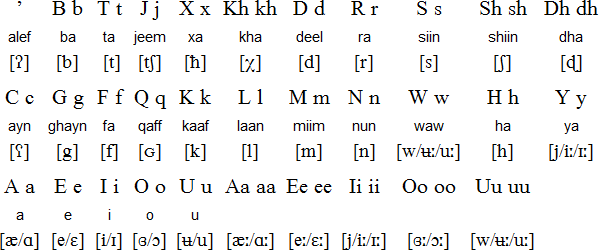
Sample text
Aadanaha dhammaantiis wuxuu dhashaa isagoo xor ah kana siman xagga sharafta iyo
xuquuqada Waxaa Alle (Ilaah) siiyay aqoon iyo wacyi, waana in qof la arkaa qofka
kale ula dhaqmaa si walaaltinimo ah.
Translation
All human beings are born free and equal in dignity and rights. They
are endowed with reason and conscience and should act towards one another
in a spirit of brotherhood.
(Article 1 of the Universal Declaration of Human Rights)
